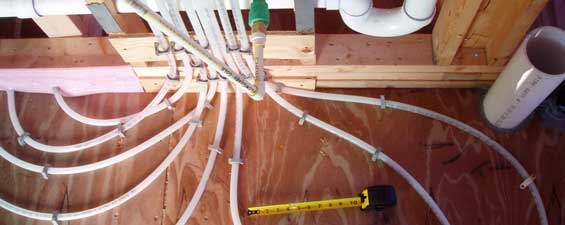
Heating Selection Summary
Our team has selected a hydronic radiant floor heating system to heat our home. Radiant floors are quiet and clean. Radiant floor heating is easily zoned to heat only select areas of the house that are currently in use for more energy savings. In the LEAFHouse, most of the heat required by the hydronic radiant system is provided by the solar hot water collectors; the electric hot water heater acts only as a backup.
LEAFHouse uses a modular radiant subfloor system delivered from the manufacturer ready to install just like a conventional subfloor (no need to pour a concrete composite slab.) This is a relatively low-mass system, allowing us to achieve faster heating and cool-down response(better control).
How does it work?
Unlike convential forced hot air (FHA) systems, which heat the air and blow it into around the house, radiant floors are designed to transfer their each directly to the occupants of the house. This makes radiant floor systems more efficient than other convential heating systems.
Water is heated by the sun (solar hot water collectors) or by a hot water heater, and is pumped slowly through tubes in the floor. The floor is made of a high density wood composite topped with a sheet of aluminum, which distributes the heat evenly across the surface (no hot or cold spots). Radiant floors provide comfort through the full spectrum of heat transfer modes: conduction, convection and radiation (FHA uses convection alone). Anything in contact with the floor is heated via conduction (including people, furniture, etc.), cool air is heated by the floor and rises, providing heat to the spaces via convection, and heat passes from the warm air to cooler surfaces in the house through radiation (similar to how a fireplace works, but much more evenly).
An Ancient Technology
Radiant technology is actually an old technology; in fact, ancient Romans used this method to heat public baths. More recently, during the mid 1960’s and 70’s, radiant floor heating gained popularity due to its superior comfort and energy efficiency. During this time, copper piping was typically used inside concrete floors. The main problem with these systems, however, was corrosion of the copper material.
Today, polyethelene is used in place of copper tubing, noted highly for its greater flexibility, corrosion resistance, and heat transfer. Cross-linked polyethelene (PEX) tubing was developed to further enhance the materials properties. According to the Radiant Panel Association, cross-linking is: "a three dimensional molecular bond created within the structure of the plastic which dramatically improves a large number of properties such as heat deformation, abrasion, chemical and stress crack resistance. Impact and tensile strength are increased, shrinkage decreased and low temperature properties improved. Cross-linked tubes also have a shape memory which only requires the addition of heat to return it to it's original shape when kinked". For a more detailed technical explanation of the various cross-linking processes, try this link:
http://www.radiantpanelassociation.org/public/articles/details.cfm?id=14
The Flooring Material
A wide rvariety of radiant floor systems and materials are available today. Generally, the subfloor may be either a poured slab (concrete, gypkrete, etc.) or a form of sheet subfloor (high density cellulose / mineral composite such an MDF) with metal plate conductors. The heating elements may be tubes carrying hot water as described above, or electric wires).
The advantage of the poured slab option is that it distributes heat evenly and holds the heat longer. The slab can do double duty as a passive solar absorber. The problem with in-slab systems is they take longer to heat up and cool down, making them harder to control. Any breakage in the tubes of wires requires that the slab be broken open. Slabs floor are heavier and more difficult to install.
The advantages of the sheet subfloor systems is that they are relatively lightweight, easier to install and maintain, and have a faster heat-up and cool-down response (better control). These are some of the reasons we selected this type of system for LEAFHouse.
Hydronic radiant floors as described above are generally more economical and effective for larger heating zones (800+ square feet). Electric systems are generally used in smaller applications (less than 800 sq.ft.).
 Team
Team  House
House  Story
Story  Sponsors
Sponsors  Webcam
____________________________________________________________________________________________________________________________________________________________________________________________________________________________________________________________________________________________________________________________________________________________________________________________________________________
____________________________________________________________________________________________________________________________________________________________________________________________________________________________________________________________________________________________________________________________________________________________________________________________________________________
Webcam
____________________________________________________________________________________________________________________________________________________________________________________________________________________________________________________________________________________________________________________________________________________________________________________________________________________
____________________________________________________________________________________________________________________________________________________________________________________________________________________________________________________________________________________________________________________________________________________________________________________________________________________
 Team
Team  House
House  Story
Story  Sponsors
Sponsors  Webcam
____________________________________________________________________________________________________________________________________________________________________________________________________________________________________________________________________________________________________________________________________________________________________________________________________________________
____________________________________________________________________________________________________________________________________________________________________________________________________________________________________________________________________________________________________________________________________________________________________________________________________________________
Webcam
____________________________________________________________________________________________________________________________________________________________________________________________________________________________________________________________________________________________________________________________________________________________________________________________________________________
____________________________________________________________________________________________________________________________________________________________________________________________________________________________________________________________________________________________________________________________________________________________________________________________________________________



